-
Software
- Analog Expert Software and Tools
- Automotive Software and Tools
- Functional Safety Software
- DSC Developer Resources
- i.MX Developer Resources
- Developer Resources
- QorIQ Developer Resources
- RFID Developer Resources
- Sensor Toolbox
- Development Software
- Embedded Software
- eIQ Auto ML SW Environment
- eIQ AI Development Environment
- Software Library
- NXP Platform Accelerator
-
Development Software
- CodeWarrior Development Tools
- Processor Expert Software
- MCUXpresso Software and Tools
- Software for Networking
- S32 SDK
- Enhanced Time Processor Unit
- eTPU General Function Set
- Expansion Board Hub
- FreeMASTER Run-Time Debugging Tool
- GUI Guider
- LIBUSBSIO Host Library for USB Enabled MCUs
- MFi Accessory Software Development Kit (SDK)
- Motor Control Application Tunning
- Real-Time Edge Software
- Security Enablement on NXP Microcontrollers
-
MCUXpresso Software and Tools
- LPCOpen Libraries and Examples
- LPCXpresso Boards
- MCU Programming
- Audio software for NXP Arm Cortex M based MCUs
- Cloud Connectivity on NXP Microcontrollers
- LinkServer for Microcontrollers
- MCU Bootloader for NXP Microcontrollers
- MCU-Link Debug Probe
- MCUXpresso Config Tools: Pins, Clocks and Peripherals
- MCUXpresso Graphical User Interfaces
- MCUXpresso Installer
- MCUXpresso Integrated Development Environment (IDE)
- MCUXpresso Secure Provisioning Tool
- MCUXpresso Software Development Kit (SDK)
- Open-CMSIS-Packs
- SDK Examples for Wireless MCUs
- Specialized Peripherals and Accelerators for NXP Microcontrollers
- Touch Sensing on NXP Microcontrollers
- Touch Software
- Wired Communications Middleware for NXP Microcontrollers
- Getting Started with the MCU Bootloader for NXP microcontrollers
Getting Started with the MCU Bootloader for NXP microcontrollers
Contents of this document
-
1
Plug It In -
2
Get Software -
3
Install and Import
Sign in to save your progress. Don't have an account? Create one.

Purchase your MCU Bootloader for NXP Microcontrollers
1. Plug It In
1.2 Plug it in
Connect the board to the PC via the USB cable between the OpenSDA USB port on the board and the USB connector on the PC.
Something went wrong! Please try again.
1.3 OpenSDA
Kinetis MCU boards are supplied with OpenSDA firmware pre-loaded. For software development on the MCU board, make sure the latest OpenSDA driver is on the Freedom development board. This allows debugging, flash programming and serial communication over a USB cable. Find the latest OpenSDA firmware for the boards here:
OpenSDA Update to the boardsFor the example, FRDM-K64F, go to this website and choose board FRDM-K64F to get the latest OpenSDA firmware.
Something went wrong! Please try again.
1.4 PC Configuration
The output data from the provided example applications are provided over the MCU UART. This requires that the driver for the board’s virtual COM port is installed. The board MUST be plugged into the PC before the driver installer is run.
The links for the latest OpenSDA Windows serial port drivers are provided on the same web:
OpenSDA Update to the boardsFor the example, FRDM-K64F, go to this website and choose board FRDM-K64F. In the coming webpage, click on Arm CMSIS-DAP serial drivers to download Windows Serial Port Drivers.
Once the Windows Serial Port Drivers are installed on the PC, determine the port number of the FRDM board’s virtual COM port by opening the device manager and looking under the "Ports" group.
Note: All the Serial Port Drivers are included and installed automatically when installing MCUXpresso IDE. Skip this step and jump to section 2 if MCUXpresso IDE is planned to install.
The demonstration board is now ready to communicate with the PC.
Something went wrong! Please try again.
2. Get Software
2.1 Get MCU Bootloader
- Choose desired device part number from the drop down menu below.
- Click on the appropriate OS type, which will begin steps for downloading.
Download MCU Bootloader
- For this example, FRDM-K64F board, Windows OS, MCUXpresso IDE, middleware MCUBOOT and USB stack are selected.
Something went wrong! Please try again.
2.2 Build the SDK
Click on Download SDK. A pop-up window SDK Download will show when the package is built successfully. Click on Download SDK Archive to download the package. The package is provided as a zip file.
Something went wrong! Please try again.
2.3 Install Your Toolchain
NXP offers a complimentary toolchain called MCUXpresso IDE.
 Get MCUXpresso IDE
Get MCUXpresso IDE
Want to use a different toolchain?
No problem! The MCUXpresso SDK includes support for other tools such as IAR, Keil.

Something went wrong! Please try again.
3. Install and Import
3.1 Install and Import
Install the downloaded FRDM-K64F SDK package into MCUXpresso IDE (Simply drag and drop the zipped SDK package as it is to the “Installed SDKs” view).

Once the SDK installation is completed, click on ‘Import SDK examples’.
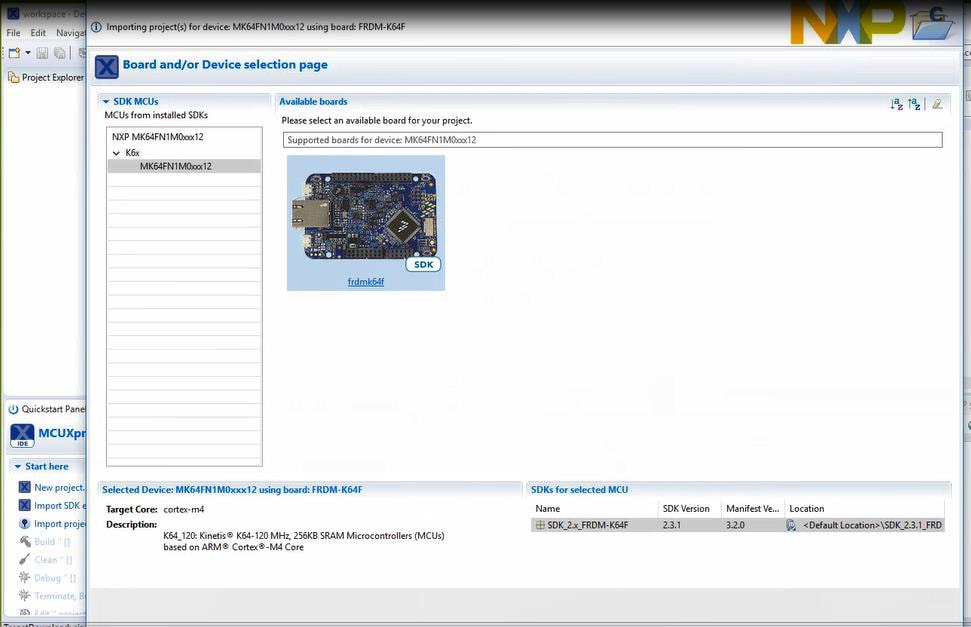
Import freedom_bootloader example from the list of available projects.
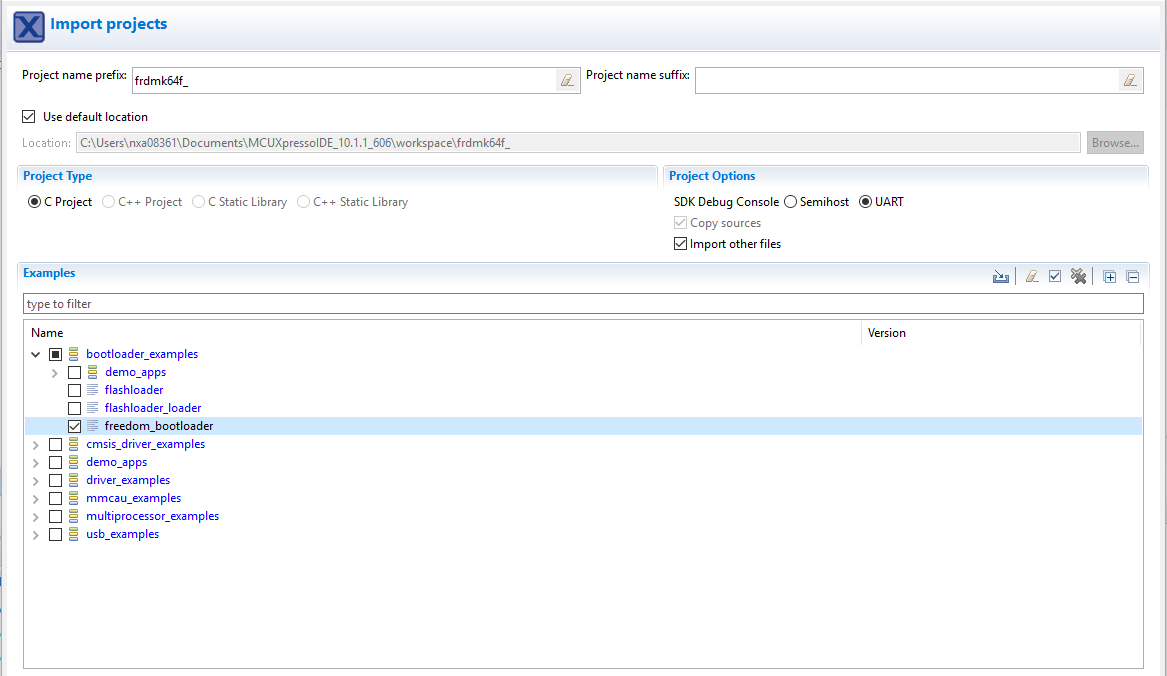
Note: Once, the freedom_bootloader example is imported successfully, the MCUXpresso IDE automatically creates the corresponding standalone project in your workspace.
Something went wrong! Please try again.
3.2 Build and Load
Build the project by clicking 'build' button.
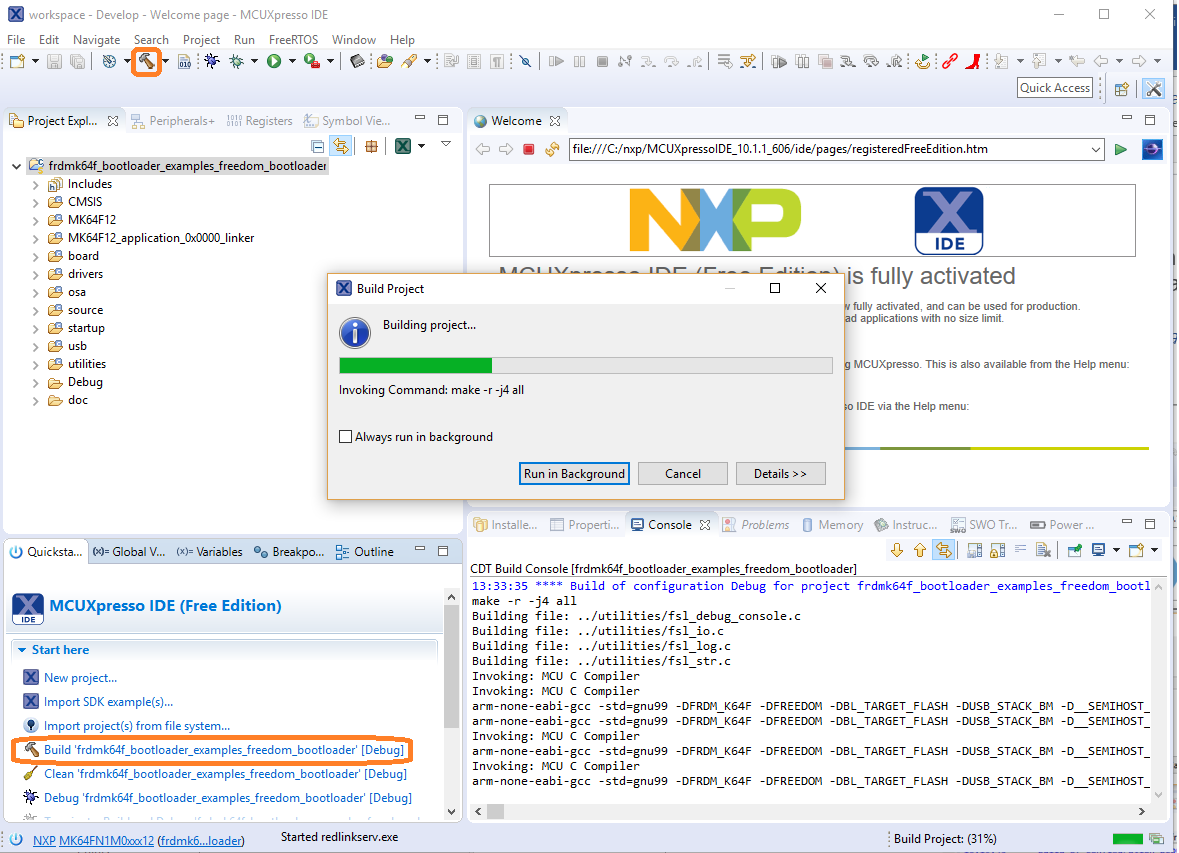
Load firmware by clicking on “Debug frdmk64fxx”
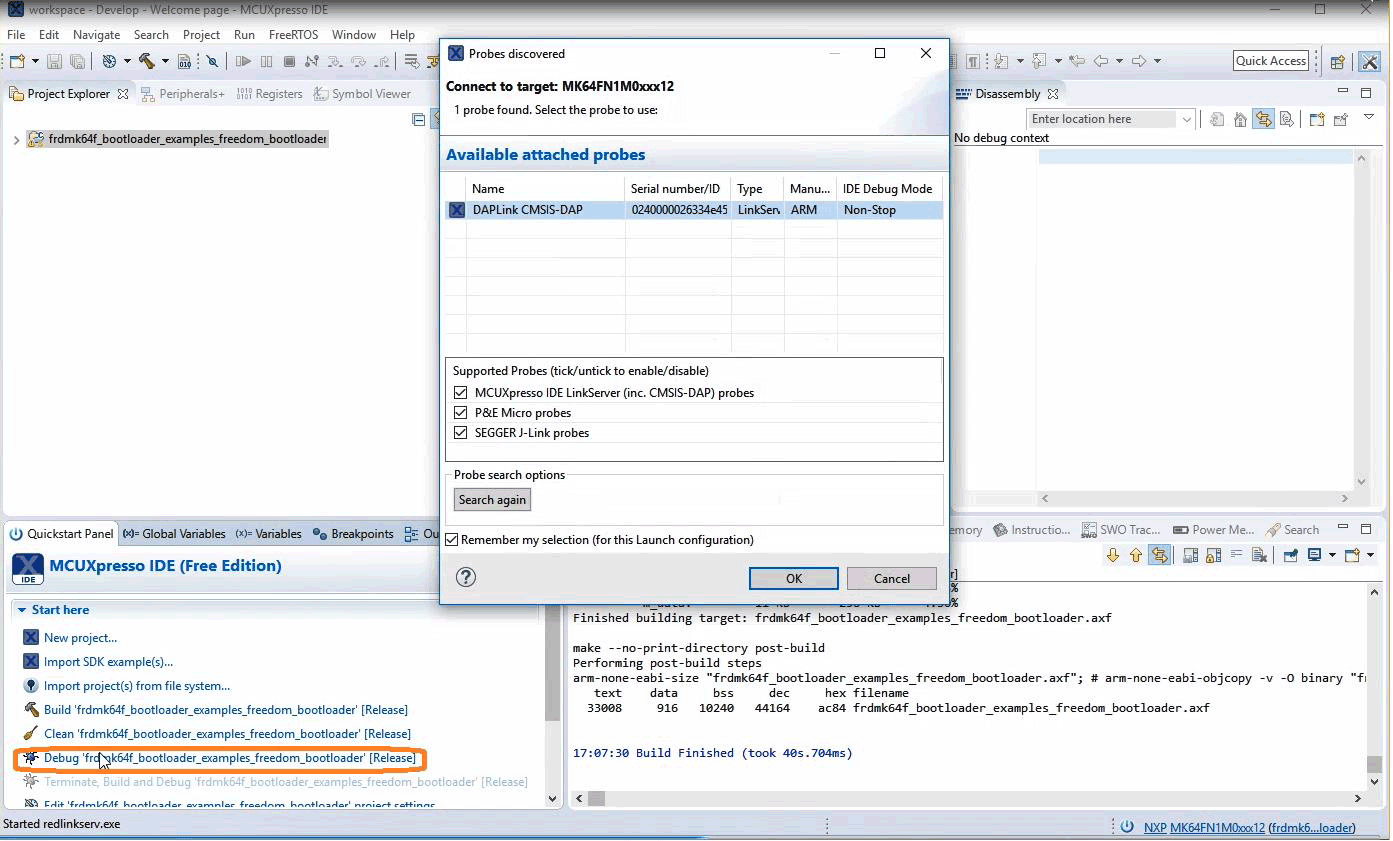
Something went wrong! Please try again.
3.3 Run blhost
Before running blhost, get the port number of the FRDM board’s virtual COM port by opening the device manager and looking under the "Ports" group.
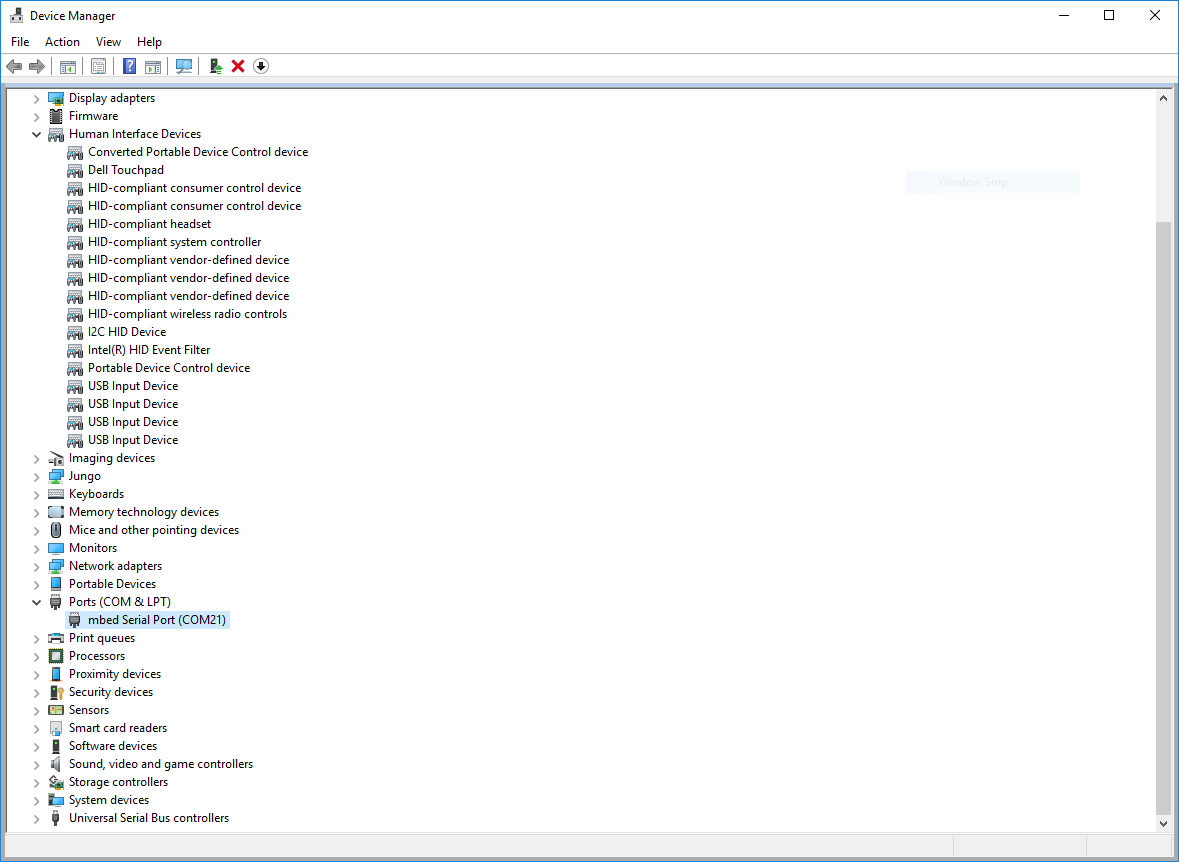
In downloaded package, Windows blhost is located at
middleware\mcu-boot\bin\Tools\blhost\win.
Open a command prompt and run blhost to initiate communication and inject commands to the bootloader. For instance, you can connect to bootloader over UART with an option "-p" and run blhost command get-property to get some information from bootloader.
Type blhost -p COM21 -- get-property 12 to get memory regions reserved by the Bootloader.
Type blhost -p COM21 -- get-property 1 to get current bootloader version.
For more details, please refer to blhost User’s Guide.
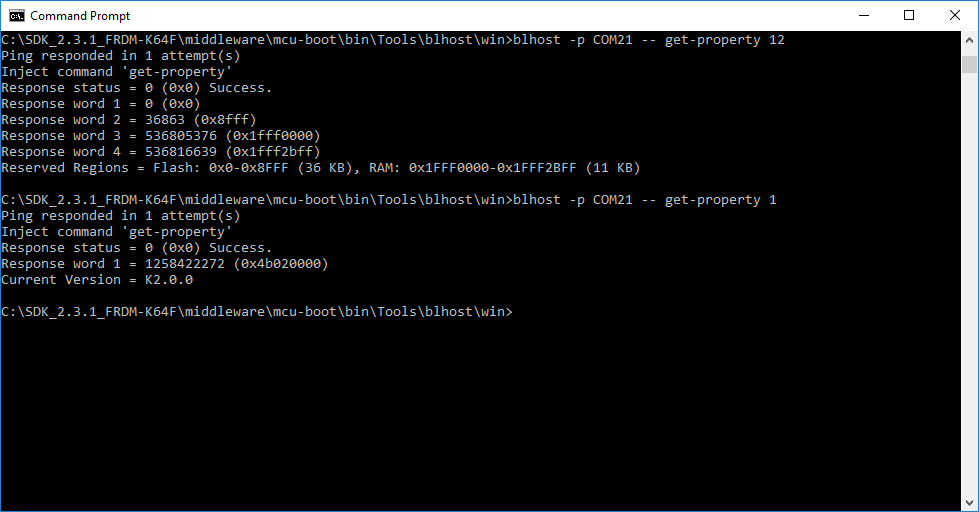
Tera Term Tutorial
Tera Term is a very popular open source terminal emulation application. This program can be used to display information sent from your NXP development platform's virtual serial port.
- Download Tera Term from SourceForge. After the download, run the installer and then return to this webpage to continue.
- Launch Tera Term. The first time it launches, it will show you the following dialog. Select the serial option. Assuming your board is plugged in, there should be a COM port automatically populated in the list.
- Configure the serial port settings (using the COM port number identified earlier) to 115200 baud rate, 8 data bits, no parity and 1 stop bit. To do this, go to Setup -> Serial Port and change the settings.
- Verify that the connection is open. If connected, Tera Term will show something like below in its title bar.
- You're ready to go
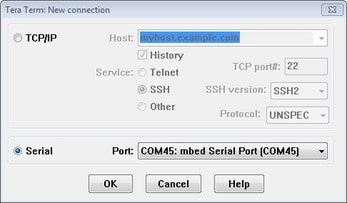

PuTTY Tutorial
PuTTY is a popular terminal emulation application. This program can be used to display information sent from your NXP development platform's virtual serial port.
- Download PuTTY using the button below. After the download, run the installer and then return to this webpage to continue.
- Launch PuTTY by either double clicking on the *.exe file you downloaded or from the Start menu, depending on the type of download you selected.
- Configure In the window that launches, select the Serial radio button and enter the COM port number that you determined earlier. Also enter the baud rate, in this case 115200.
- Click Open to open the serial connection. Assuming the board is connected and you entered the correct COM port, the terminal window will open. If the configuration is not correct, PuTTY will alert you.
- You're ready to go
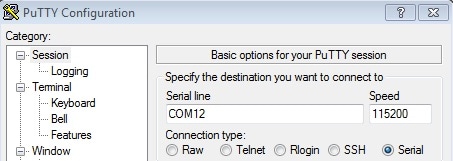
Demo not working?
Did your board come in a box that looks like this?

No problem! Your board simply came in the old packaging and has a different out-of-box demo loaded into the flash memory.
You should be seeing the RGB LED toggling between each of the three colors; red, blue and green. It's OK to move onto the next step when you're ready.
Still not working?
Try proceeding to the next steps to get other example applications running on your board. If you still have problems, try contacting us through the NXP Community.
Running a demo using IAR
1. Build an Example Application
The following steps will guide you through opening the hello_world application. These steps may change slightly for other example applications as some of these applications may have additional layers of folders in their path.
-
If not already done, open the desired example application workspace. Most example application workspace files can be located using the following path:
<install_dir>/boards/<sdk_board_name>/<example_type>/<application_name>/iar
Using the hello_world demo as an example, the path is:
<install_dir>/boards/frdmk64f/demo_apps/hello_world/iar
-
Select the desired build target from the drop-down. For this example, select the “hello_world – Debug” target.

-
To build the application, click the “Make” button, highlighted in red below.
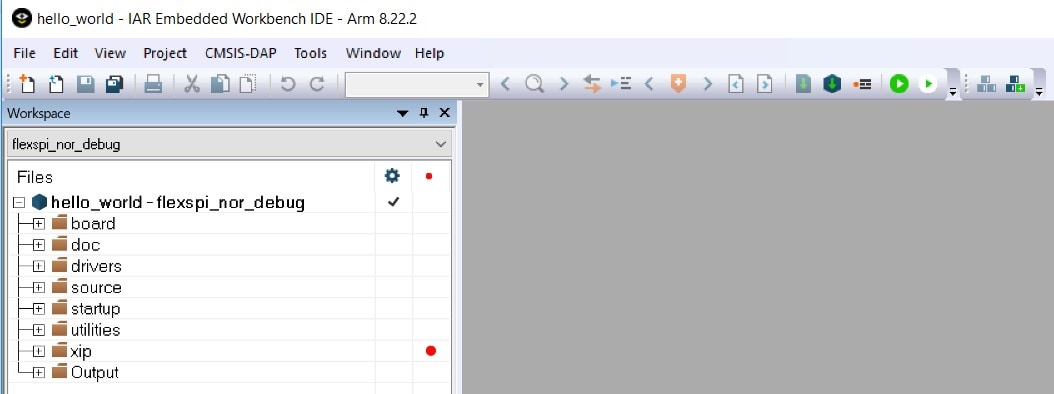
-
The build will complete without errors:
2. Run an Example Application
The FRDM-K64F board comes loaded with the mbed/CMSIS-DAP debug interface from the factory. If you have changed the debug OpenSDA application on your board, visit http://www.nxp.com/opensda for information on updating or restoring your board to the factory state.
-
Connect the development platform to your PC via USB cable between the "SDAUSB" USB port on the board and the PC USB connector.
-
Open the terminal application on the PC (such as PuTTY or TeraTerm) and connect to the debug COM port you determined earlier. Configure the terminal with these settings:
- 15200 baud rate
- No parity
- 8 data bits
- 1 stop bit
-
Click the "Download and Debug" button to download the application to the target.

-
The application is then downloaded to the target and automatically runs to the main() function.

-
Run the code by clicking the "Go" button to start the application.

-
The hello_world application is now running and a banner is displayed on the terminal. If this is not the case, check your terminal settings and connections.
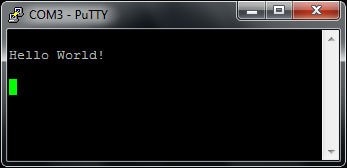
Running a demo using Keil® MDK/µVision®
1. Install CMSIS device pack
After the MDK tools are installed, Cortex® Microcontroller Software Interface Standard (CMSIS) device packs must be installed to fully support the device from a debug perspective. These packs include things such as memory map information, register definitions and flash programming algorithms. Follow these steps to install the appropriate CMSIS pack.
-
Open the MDK IDE, which is called µVision. In the IDE, select the "Pack Installer" icon.

-
In the Pack Installer window, navigate to the section with the Kinetis packs (they are in alphabetical order). The Kinetis packs start with "Keil::Kinetis" and are followed by the MCU family name, for example, "Keil::Kinetis_K60_DFP". Because this example uses the FRDM-K64F platform, the K60 family pack is selected. Click on the "Install" button next to the pack. This process requires an Internet connection to successfully complete.

-
After the installation finishes, close the Pack Installer window and return to the µVision IDE.
2. Build the Example Application
The following steps will guide you through opening the hello_world application. These steps may change slightly for other example applications as some of these applications may have additional layers of folders in their path.
-
If not already done, open the desired demo application workspace in:
<install_dir>/boards/<sdk_board_name>/<example_type>/<application_name>/mdk
The workspace file is named <application_name>.uvmpw, so for this specific example, the actual path is:
<install_dir>/boards/frdmk64f/demo_apps/hello_world/mdk/hello_world.uvmpw
-
To build the demo project, select the "Rebuild" button, highlighted in red.

-
The build will complete without errors.
3. Run an Example Application
The FRDM-K64F board comes loaded with the mbed/CMSIS-DAP debug interface from the factory. If you have changed the debug OpenSDA application on your board, visit http://www.nxp.com/opensda for information on updating or restoring your board to the factory state.
-
Connect the development platform to your PC via USB cable between the "SDAUSB" USB port on the board and the PC USB connector.
-
Open the terminal application on the PC (such as PuTTY or TeraTerm) and connect to the debug COM port you determined earlier. Configure the terminal with these settings:
- 15200 baud rate
- No parity
- 8 data bits
- 1 stop bit
-
After the application is properly built, click the "Download" button to download the application to the target.

-
After clicking the "Download" button, the application downloads to the target and should be running. To debug the application, click the "Start/Stop Debug Session" button, highlighted in red.

-
Run the code by clicking the "Run" button to start the application.

-
The hello_world application is now running and a banner is displayed on the terminal. If this is not the case, check your terminal settings and connections.
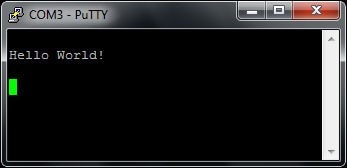
Running a demo using MCUXpresso IDE
1. Import the MCUXpresso SDK
- Open up the MCUXpresso IDE
-
Switch to the Installed SDKs view within the MCUXpresso IDE
window
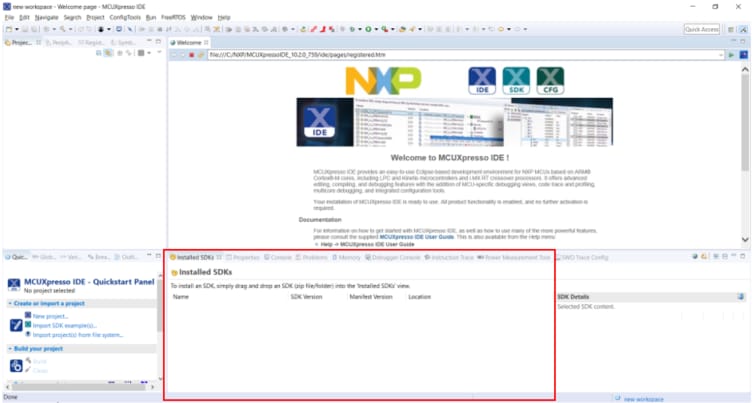
- Open Windows Explorer, and drag and drop the FRDM-K64F SDK (unzipped) file into the Installed SDKs view.
-
You will get the following pop-up. Click on
OK to continue the import:
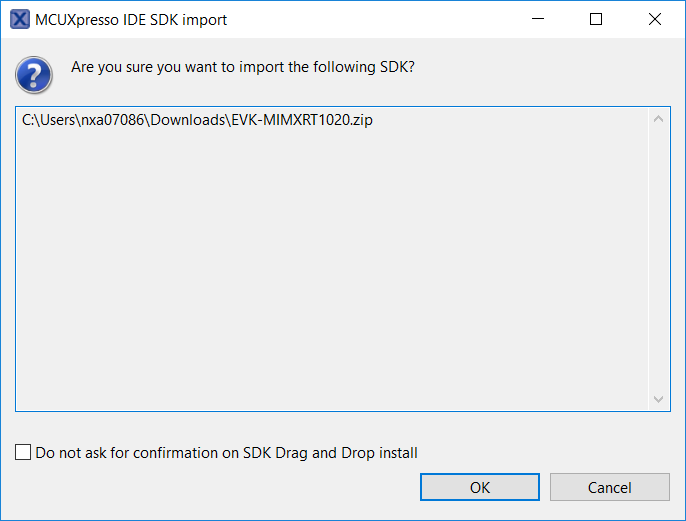
-
The installed SDK will appear in the Installed SDKs view as
shown below:

2. Build an Example Application
The following steps will guide you through opening the hello_world example.
-
Find the Quickstart Panel in the lower left hand corner
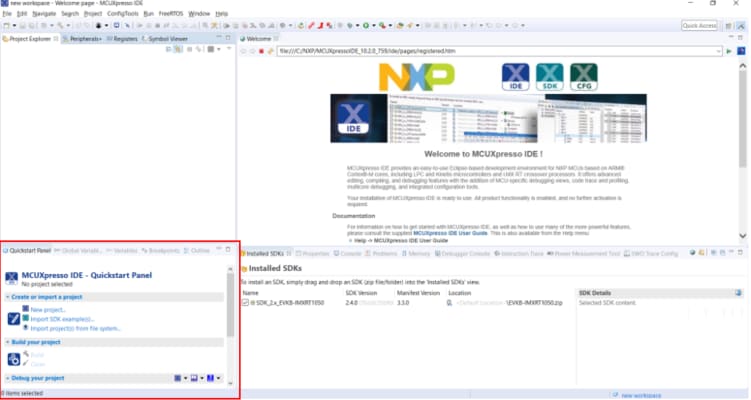
-
Then click on Import SDK examples(s)…
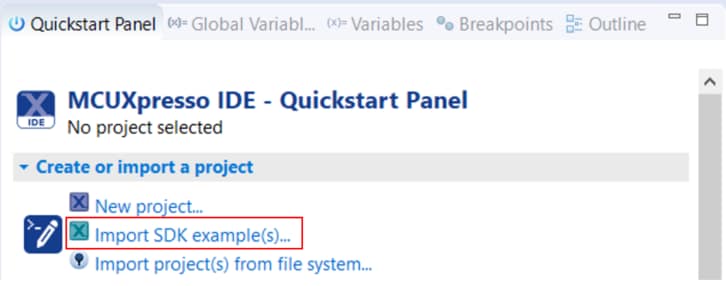
-
Click on the frdmk64f board to select that you want to import an example that can run on that board, and then click on Next.
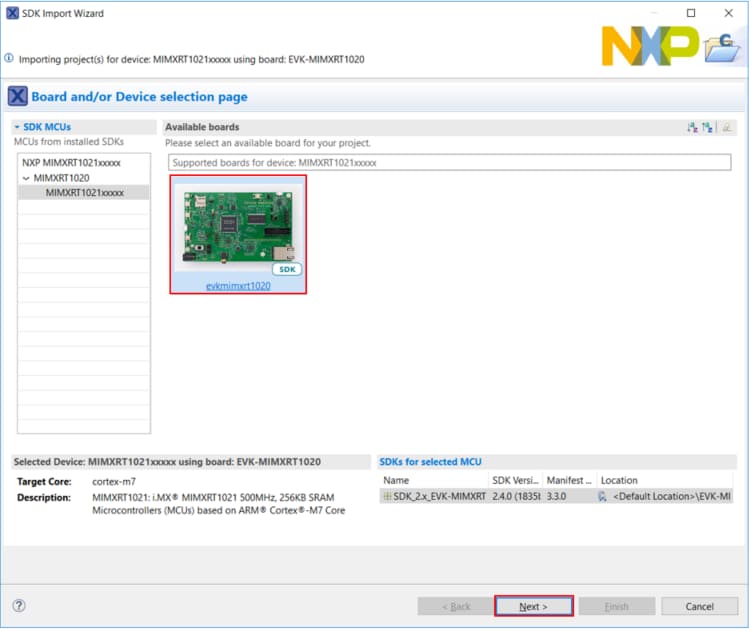
-
Use the arrow button to expand the demo_apps category, and then click the checkbox next to hello_world to select that project. To use the UART for printing (instead of the default semihosting), clear the “Enable semihost” checkbox under the project options. Then, click on Next.
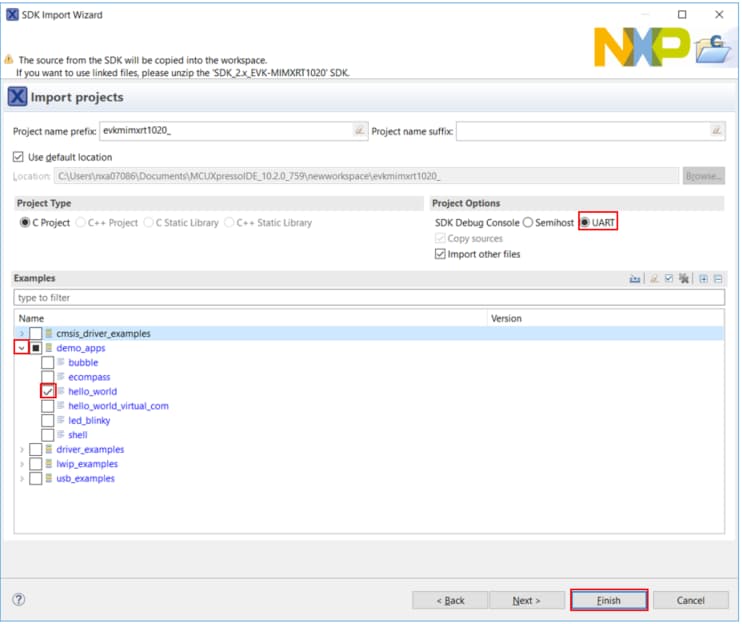
-
On the Advanced Settings wizard, clear the checkbox “Redirect SDK “PRINTF” to C library “printf”“ in order to use the MCUXpresso SDK console functions for printing instead of generic C library ones. Then click on Finish.
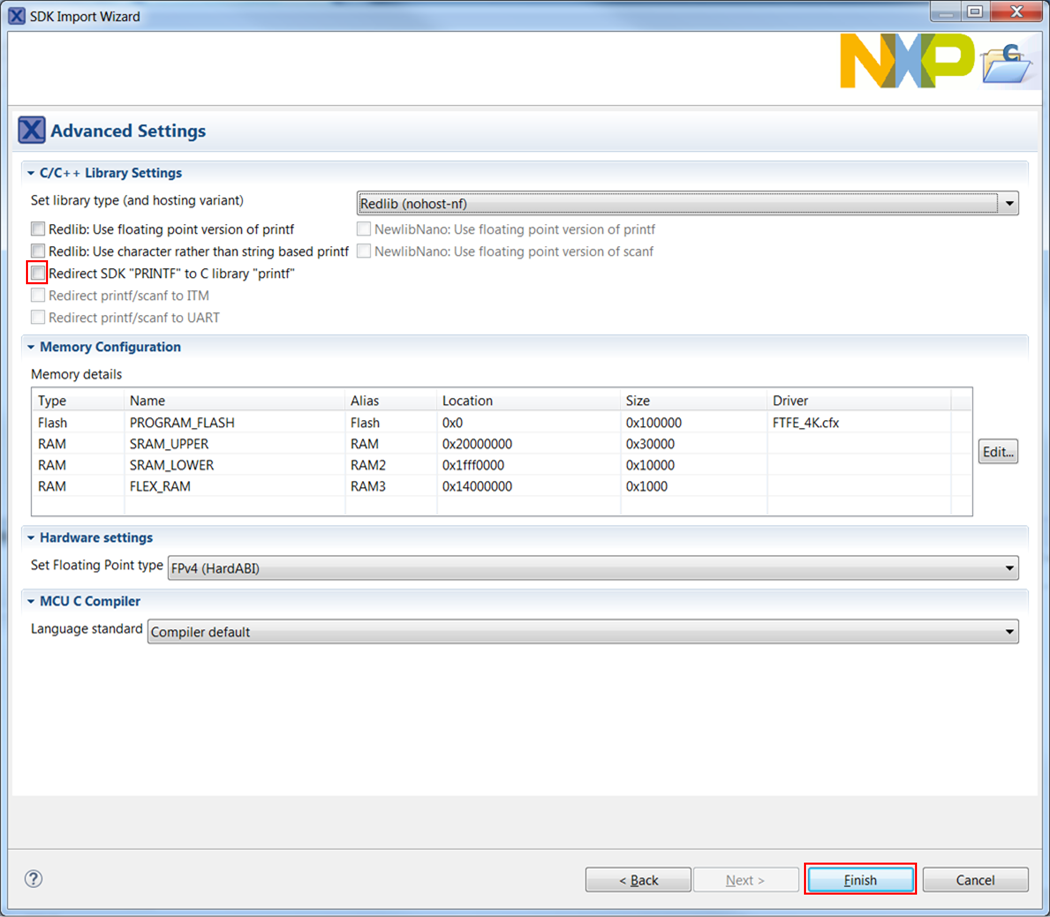
-
Now build the project by clicking on the project name and then click on the Build icon.
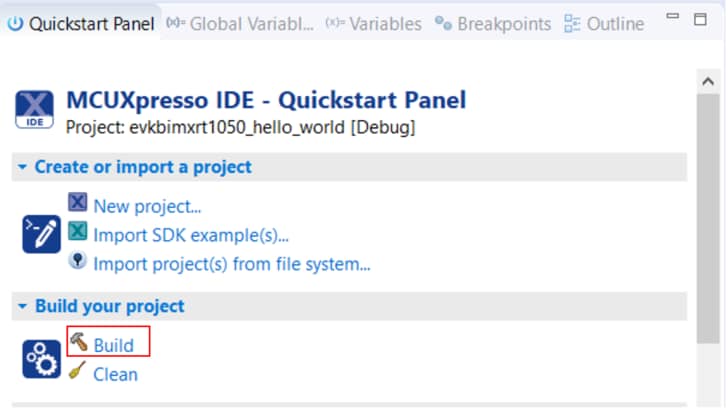
-
You can see the status of the build in the Console tab.

3. Run an Example Application
- Now that the project has been compiled, you can now flash it to the board and run it.
-
Make sure that the FRDM-K64F board is plugged in, and click
on
Debug ‘frdmk64f_demo_apps_hello_world’ [Debug]
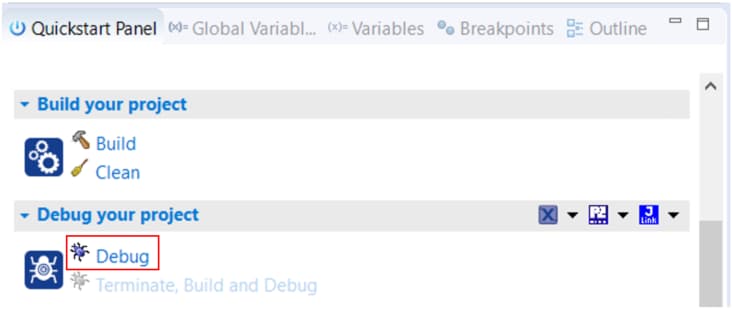
-
MCUXpresso IDE will probe for connected boards and should find the MBED CMSIS-DAP debug probe that is part of the integrated OpenSDA circuit on the FRDM-K64F. Click on OK to continue.
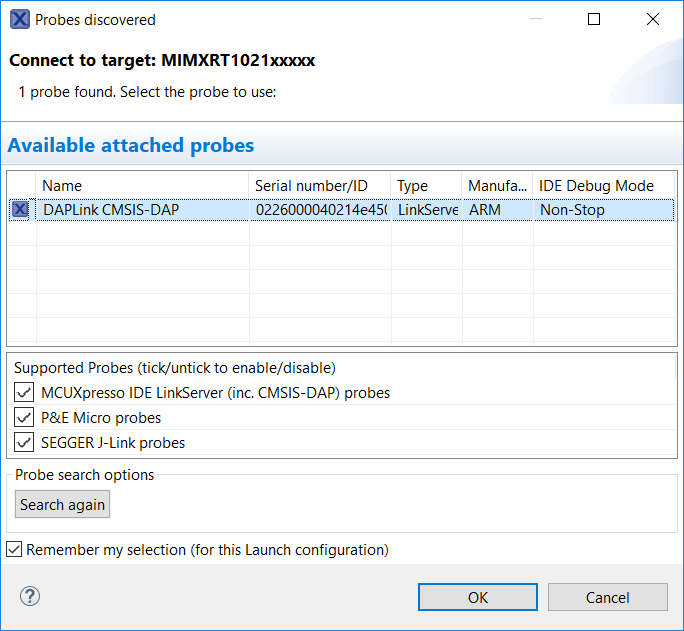
-
The firmware will be downloaded to the board and the debugger started.

-
Open up a terminal program and connect to the COM port the board enumerated as. Use 115200 baud 8 data bits, no parity and 1 stop bit.
-
Start the application by clicking the "Resume" button:
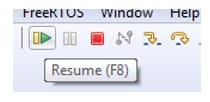
-
The hello_world application is now running and a banner is displayed on the terminal. If this is not the case, check your terminal settings and connections.

-
Use the controls in the menu bar to pause, step into, and step over instructions and then stop the debugging session by click on the Terminate icon:

Running a demo using Arm
1. Set Up Toolchain
This section contains the steps to install the necessary components required to build and run a KSDK demo application with the Arm GCC toolchain, as supported by the Kinetis SDK. There are many ways to use Arm GCC tools, but this example focuses on a Windows environment. Though not discussed here, GCC tools can also be used with both Linux OS and Mac OSX.
Install GCC Arm Embedded Toolchain
Download and run the installer from launchpad.net/gcc-arm-embedded. This is the actual toolchain (i.e., compiler, linker, etc.). The GCC toolchain should correspond to the latest supported version, as described in the Kinetis SDK Release Notes.
Install MinGW
The Minimalist GNU for Windows (MinGW) development tools provide a set of tools that are not dependent on third-party C-Runtime DLLs (such as Cygwin). The build environment used by the KSDK does not use the MinGW build tools, but does leverage the base install of both MinGW and MSYS. MSYS provides a basic shell with a Unix-like interface and tools.
-
Download the latest MinGW mingw-get-setup installer from sourceforge.net/projects/mingw/files/Installer/.
-
Run the installer. The recommended installation path is C:\MinGW, however, you may install to any location.
-
Ensure that the "mingw32-base" and "msys-base" are selected under Basic Setup.

-
Click "Apply Changes" in the "Installation" menu and follow the remaining instructions to complete the installation.
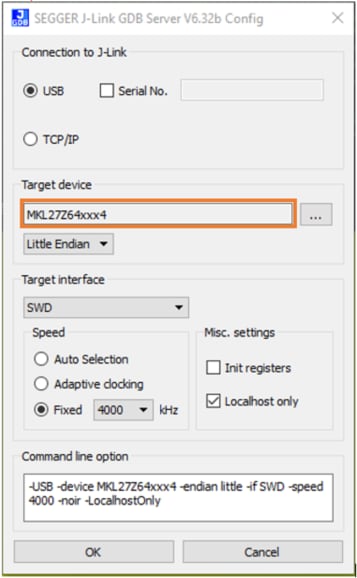
-
Add the appropriate item to the Windows operating system Path environment variable. It can be found under Control Panel -> System and Security -> System -> Advanced System Settings in the "Environment Variables..." section. The path is:
<mingw_install_dir>\bin
Assuming the default installation path, C:\MinGW, an example is shown below. If the path is not set correctly, the toolchain does not work.
NOTE
If you have "C:\MinGW\msys\x.x\bin" in your PATH variable (as required by KSDK 1.0.0), remove it to ensure that the new GCC build system works correctly.
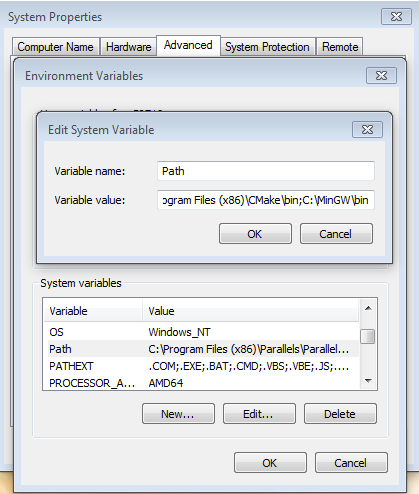
-
Download CMake 3.0.x from www.cmake.org/cmake/resources/software.html.
-
Install CMake, ensuring that the option "Add CMake to system PATH" is selected when installing. It's up to the user to select whether it's installed into the PATH for all users or just the current user. In this example, the assumption is that it's installed for all users.

-
Follow the remaining instructions of the installer.
-
You may need to reboot your system for the PATH changes to take effect.
NOTE
The installation path cannot contain any spaces.
Add a New Environment Variable for ARMGCC_DIR
Create a new system environment variable and name it ARMGCC_DIR. The value of this variable should point to the Arm GCC Embedded tool chain installation path, which, for this example, is:
C:\Program Files (x86)\GNU Tools Arm Embedded\4.9 2015q3
Reference the installation folder of the GNU Arm GCC Embedded tools for the exact pathname of your installation.
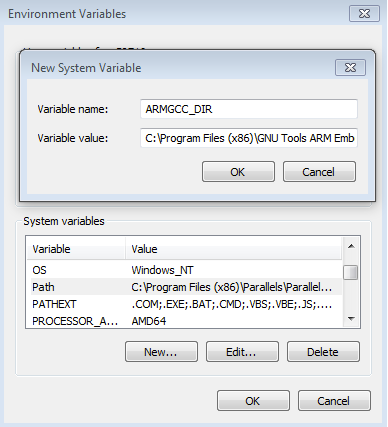
Install CMake
2. Build an Example Application
To build an example application, follow these steps.
-
1. If not already running, open a GCC Arm Embedded tool chain command window. To launch the window, from the Windows operating system Start menu, go to “Programs -> GNU Tools Arm Embedded <version>” and select “GCC Command Prompt”.

-
Change the directory to the example application project directory, which has a path like this:
<install_dir>/boards/<board_name>/<example_type>/<application_name>/armgcc
For this guide, the exact path is:
<install_dir>/boards/frdmk64f/demo_apps/hello_world/armgcc
-
Type “build_debug.bat” on the command line or double click on the "build_debug.bat" file in Windows operating system Explorer to perform the build. The output is shown in this figure:

3. Run an Example Application
The GCC tools require a J-Link debug interface. To update the OpenSDA firmware on your board to the latest J-Link app, visit www.nxp.com/opensda. After installing the J-Link OpenSDA application, download the J-Link driver and software package from www.segger.com/downloads.html.
-
Connect the development platform to your PC via USB cable between the "SDAUSB" USB port on the board and the PC USB connector.
-
Open the terminal application on the PC (such as PuTTY or TeraTerm) and connect to the debug COM port you determined earlier. Configure the terminal with these settings:
- 15200 baud rate
- No parity
- 8 data bits
- 1 stop bit
-
Open the J-Link GDB Server application. Assuming the J-Link software is installed, the application can be launched by going to the Windows operating system Start menu and selecting "Programs -> SEGGER -> J-Link <version> J-Link GDB Server".
-
Modify the settings as shown below. The target device selection chosen for this example is the “MK64FN1M0xxx12” and use the SWD interface.

-
After it is connected, the screen should resemble this figure:

-
If not already running, open a GCC Arm Embedded tool chain command window. To launch the window, from the Windows operating system Start menu, go to "Programs -> GNU Tools Arm Embedded <version>" and select "GCC Command Prompt".

-
Change to the directory that contains the demo application output. The output can be found in using one of these paths, depending on the build target selected:
<install_dir>/boards/<board_name>/<example_type>/<application_name>/armgcc/debug
<install_dir>/boards/<board_name>/<example_type>/<application_name>/armgcc/release
For this guide, the path is:
<install_dir>/boards/frdmk64f/demo_apps/hello_world/armgcc/debug
-
Run the command "arm-none-eabi-gdb.exe <demo_name>.elf". For this example, it is "arm-none-eabi-gdb.exe hello_world.elf".

-
Run these commands:
- "target remote localhost:2331"
- "monitor reset"
- "monitor halt"
- "load"
- "monitor reset"
-
The application is now downloaded and halted at the reset vector. Execute the "monitor go" command to start the example application.
The hello_world application is now running and a banner is displayed in the terminal window.

Use MCUXpresso IDE
- Open the MCUXpresso IDE.
-
Click Import SDK Example(s) from the QuickStart Panel.

-
Select the FRDM-K64F board in the Import Wizard. Then,
select Next.
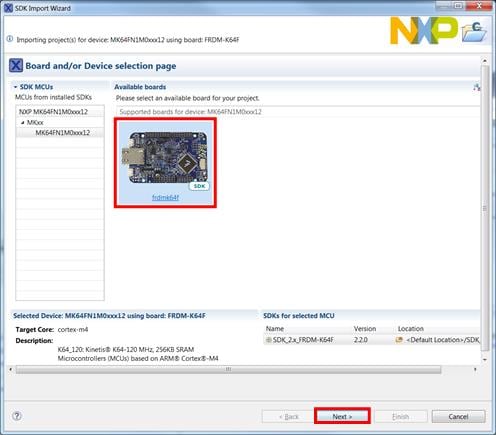
-
Type “LED” into the search bar, and select
the “led_output” project under the GPIO
driver example. Then, select Next. This
will create a new standalone copy of this LED project and
put it into the MCUXpresso workspace. To use the UART for
printing (instead of the default semihosting), clear the
“Enable semihost” checkbox under the
project options. Then, click on Next.

-
On the Advanced Settings wizard, clear the checkbox “Redirect SDK “PRINTF” to C library “printf”“ in order to use the MCUXpresso SDK console functions for
printing instead of generic C library ones. Then click on
Finish.

-
Click on the “led_output” project in the
Project Explorer View and build, compile and run the demo as
described previously.

- You should see a red LED blinking on the board.
- Terminate the debug session.
Use MCUXpresso Config Tools
- Open the MCUXpresso Config Tool.
-
In the wizard that comes up, browse to the place where the
MCUXpresso SDK was unzipped and then select the “Clone an
example project” radio button and click on Next.

-
Select the project to clone. For this example, we want to
use the LED project. You can filter for this by typing “LED”
in the filter box and then selecting the “gpio/led_output”
project. Then click on Next.

-
Then select the directory you want to place the cloned
project, give it a name and select the IDE to use. Note that
only IDEs that were selected in the online SDK builder when
the SDK was built will be available. Then click on Finish.

- After cloning go to the directory you selected and open up the project for your IDE. Import, compile and run the project as done in previous sections.
- You should see a red LED blinking on the board.
- Terminate the debug session.
Use Pins Tool
-
Open MCUXpresso Config Tools

-
The wizard will ask if you want to start development with or
without an SDK. Choose to start development with the SDK and
that we want to create a new configuration. Use the
“Browse…” button to navigate to the location of your
unzipped SDK installation.

-
Select the SDK top-level folder from your file system.
Select OK.

-
The wizard asks to create a new configuration or clone an
example project. We will Create a new configuration that
will be based on the “led_output” project settings from the
SDK. Select Next to continue.

-
Search for the led_output example by typing “LED” in the
search bar. Select the led_output example and press Finish.

-
Open the pins tool by selecting Tools->Pins from the
toolbar.

-
The pins tool should now display the pin configuration for
the led_output project.

-
In the Pins view, click the “Show Routed/All Pins” checkbox
to see all the routed pins. Routed pins have a check in a
green box next to the pin name. The functions selected for
each routed pin are highlighted in green in the table.
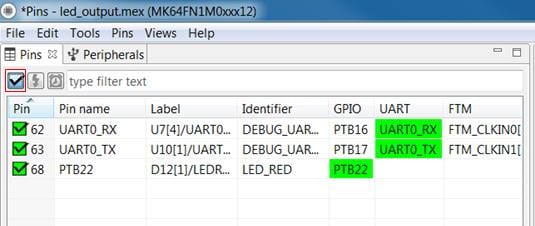
- In the current configuration, PTB22 is routed as a GPIO to toggle the red LED. Let’s disable PTB22, and change the MUX setting of PTB21 to use its GPIO functionality to drive the blue LED
-
Disable PTB22 (Red LED) as a GPIO by clicking the “PTB22”
field under the GPIO column. The pin will then be disabled
(pin will no longer have check in box) and therefore
disappear from the list.

-
Now, route PTB21 as a GPIO. First, deselect the “Show Routed
All/Pins” so that all the pins are displayed again. Then,
search PTB21 in the pins view. Finally, click the box under
the GPIO column. The box will highlight in green, and a
check will appear next to the pin.

-
The updated view will appear as below once you clear the
filtered text. Note that PTB21 also appears in the Routed
Pins tab and PTB22 has been removed. The pin_mux.c file has
been updated to reflect the change as well.
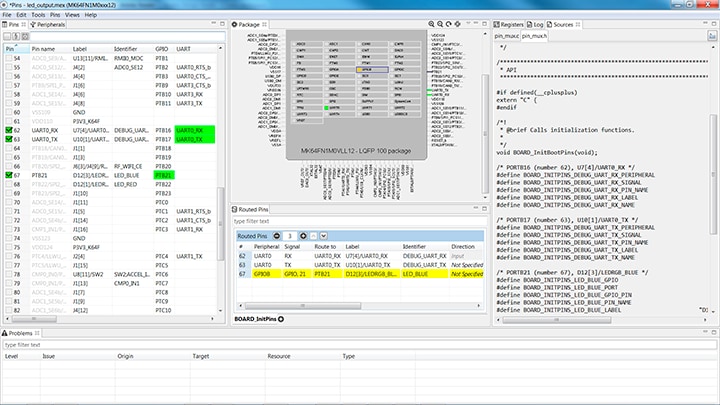
-
PTB21 already has a defined identifier (i.e. “LED_BLUE”) set
up for the FRDM-K64F for the led_output example
configuration. Now, change the identifier to “My_LED” next
to PTB21 in the Pins table by searching for PTB21. This will
add a #define to the pin_mux.h file that will be used to
identify the LED.

-
Now export the pin_mux.c and pin_mux.h files by clicking on the Sources tab on the right side to get to the Sources view, and selecting the export icon.

-
Select the directory to export the pin_mux.c and pin_mux.h files. In this example export to the “board” folder in the led_output project in the workspace that was created in the previous section.
(i.e. C:\MCUXpressoIDE_Lab\frdmk64f_driver_examples_gpio_led_output\board). Select Finish.

-
Click Yes to replace the existing pin_mux.c and pin_mux.h
files.

-
We’ll use MCUXpresso IDE for the rest of the instructions
but the same steps can be done in other 3rd party IDEs.
Under the “led_output” project, double-click the
gpio_led_output.c file in the source folder to display the
file in the editor. Notice that the macros used in the GPIO
driver functions refer to the BOARD_LED (i.e. red LED). We
need to replace these with the macros for My_LED that we
just created.

-
Double-click the pin_mux.h file under the board folder in
the “led_output” project. Since the file has been updated,
press “F5” or File > Refresh to update the file in the
editor. Copy “BOARD_INITPIN_My_LED_GPIO” in pin_mux.h.
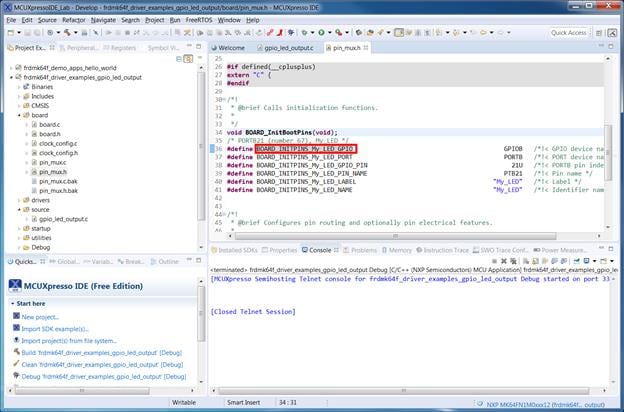
-
In gpio_led_output.c, replace “BOARD_LED_GPIO” with
“BOARD_INITPIN_My_LED_GPIO” in lines 87 and 92.
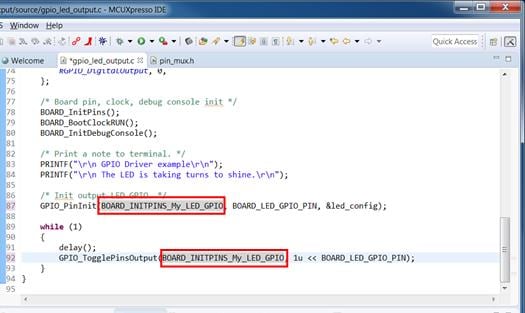
-
Similarly, copy “BOARD_INITPINS_MY_LED_GPIO_PIN” from
pin_mux.h.

-
In gpio_led_output.c, replace “BOARD_LED_GPIO_PIN” with
“BOARD_INITPIN_My_LED_GPIO_PIN” in lines 87 and 92.
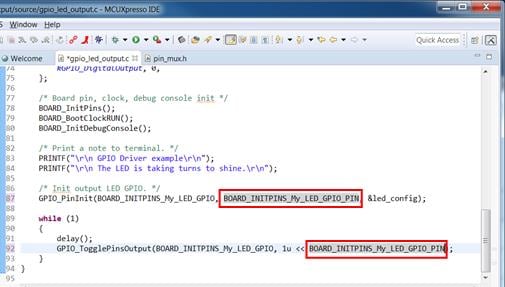
- Build and download the project as done in the previous section.
- Run the application. You should now see the blue LED blinking!
- Terminate the debug session.
Use the Clocks Tool
- Open MCUXpresso Config Tools.
-
Open the Clocks tool from the toolbar: Tools->Clocks.

-
The clock configuration for the “led_output” project will
appear in the clocks tool:
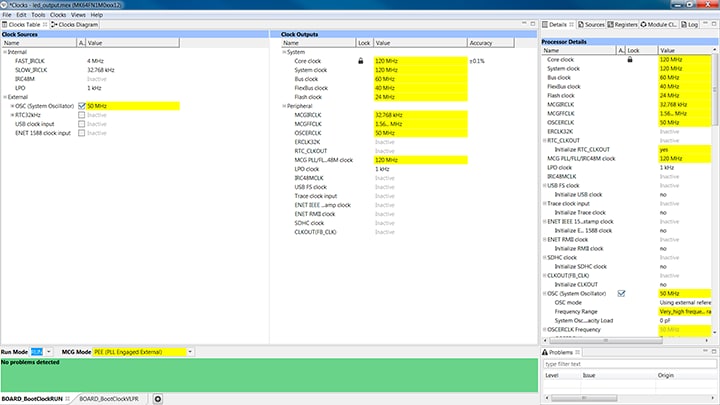
-
Switch to the Clocks Diagram view by clicking the tab in the
upper left corner, and ensure that the BOARD_BootClockRUN
clock mode is being displayed by clicking the tab in the
lower left corner.

-
Change the core clock frequency by clicking in the Core
Clock field and typing “12 MHz”. You’ll see all the
associated clock frequencies automatically change as well
then.
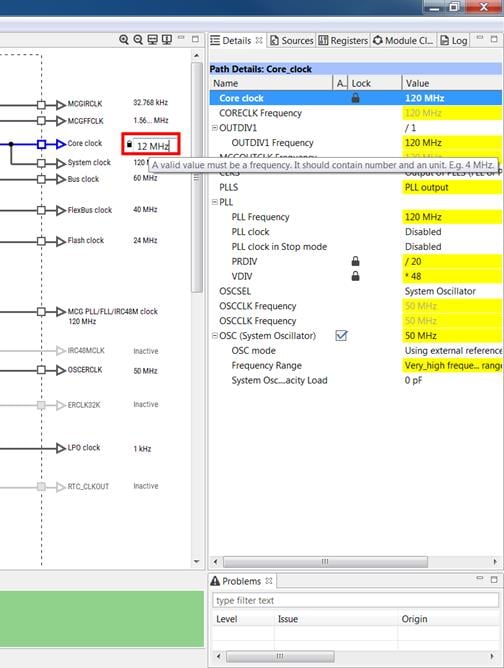
-
Now open the “Sources” tab and export the clock_config.c and
clock_config.h files.

-
Select the directory to export the clock_config.c and clock_config.h files. In this example export to the “board” folder in the led_output project in the workspace.
(i.e. C:\MCUXpressoIDE_Lab\frdmk64f_driver_examples_gpio_led_output\board). Select Finish.

-
Press Yes to replace the existing clock_config.c and
clock_config.h files.

-
Now open the LED project in your IDE, and build, download
and run the project as you did before.

- The blue LED should now be blinking at a much slower rate
Something went wrong! Please try again.
